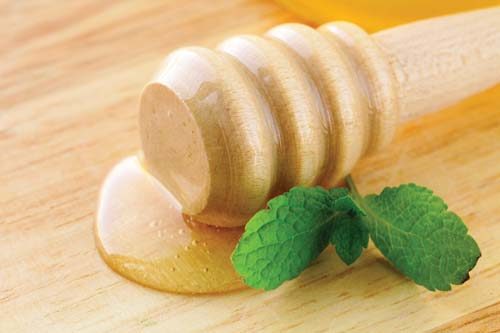Sweeteners have been all over headlines in 2012:
—“Fructose Consumption Increases Visceral Fat, Study Reports,” The New York Times, February 6, 2012
—“Sugar Seeks Sweet Revenge Against Competition from Corn,” Los Angeles Times, March 20, 2012
—“Is Sugar Toxic?” 60 Minutes, April 1, 2012
—“Rice-Sweetened Baby Formula May Contain Arsenic: U.S. Study,” Reuters, February 16, 2012
Here we brief you on the latest sweeteners news your shoppers will need to know.
The Buzz about Honey
Over the past five to six years, honeybees have been deserting their hives and dying in massive numbers throughout Europe and North America. This phenomenon has been called Colony Collapse Disorder (CCD).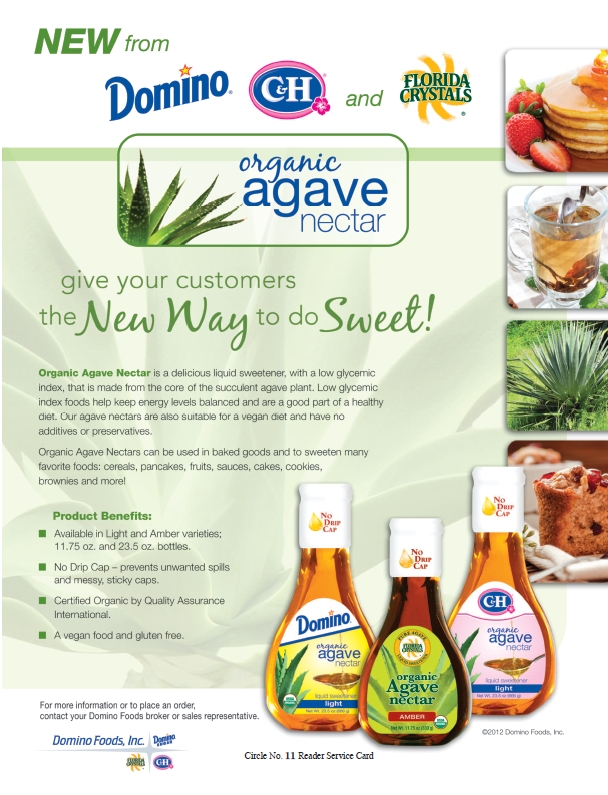
“People wonder why CCD is such a big issue,” says Monica Clem, marketing communications coordinator for Wholesome Sweeteners, Sugar Land, TX. “Most people do not realize if there are no bees, there are no humans. Honeybees pollinate 75% of the crops we eat, including fruits, vegetables and nuts. Even the beef supply is affected when honeybees die...Our food supply would disappear if the honeybee disappeared.”
Everything from viruses to mites have been studied as possible sources of CCD. But in April, a team from the Harvard School of Public Health put out a report with a new possible answer: imidacloprid. This pesticide is a neonicotinoid, developed in the 1990s to be less toxic than other pesticides, and is now widely used. “In the United States alone, neonicotinoid-treated corn now covers a total area slightly smaller than the state of Montana” (1).
Neonicotinoids get into a plant’s vascular tissue, staying in it throughout its growth and flowering (when bees come into play). The pesticide disrupts insects’ central nervous systems (1). When researchers gave the pesticide to 16 colonies of bees, 15 of them abandoned their hives and died with lower levels of imidacloprid. Interestingly, bees may not only be exposed to the chemical during pollination. Beekeepers often give their colonies high-fructose corn syrup (HFCS), which may contain the pesticide.
This isn’t the first group to blame CCD on pesticides. “Another study published in the journal Science by French researchers showed that pesticides fog the bee’s brain making it hard for it to return to the hive,” Clem states.
It should be noted that not everyone believes these studies are point-blank evidence that pesticides are causing CCD. Regardless, shoppers should know CCD is a critical issue. If pesticides are a cause, it’s even more important for shoppers to choose organic.
 It is possible to find honey that is pesticide free, Clem reminds us. “Wholesome Sweeteners only provides the purest honey from the deepest organic, protected jungles of southern Mexico and Brazil. The bees are not exposed to chemical pesticides or genetically modified crops, and the bees of these regions have never experienced a collapse. The bees forage only on organic flowers in the biodiverse jungles.”
It is possible to find honey that is pesticide free, Clem reminds us. “Wholesome Sweeteners only provides the purest honey from the deepest organic, protected jungles of southern Mexico and Brazil. The bees are not exposed to chemical pesticides or genetically modified crops, and the bees of these regions have never experienced a collapse. The bees forage only on organic flowers in the biodiverse jungles.”
Differentiating Between Sugar Alcohols
Sugar alcohols are key players in the food category. But, different “–ols” behave differently in the body, so it’s important to have a handle on these ingredients so you can appropriately handle your shoppers’ questions.
First off, a sugar alcohol isn’t sugar or alcohol. They’re made by adding hydrogen atoms to sugar, which changes its structure (2). The process occurs naturally in some plants, says Neil E. Levin, nutrition education manager for NOW Foods, Bloomingdale, IL (which offers erythritol and xylitol as bulk sweeteners and xylitol in packet form). He adds, “Nature-identical sugar alcohols are commercially produced by fermentation.”
Examples of sugar alcohols are erythritol, maltitol, sorbitol and xylitol. They contain fewer calories than sugar and have less of an impact on blood glucose levels. But, they are still carbs. Don’t let this throw you if you’re considering whether a diabetic could use such a sweetener. Says Levin, “While sugar alcohols are carbohydrates, they don’t each provide the typical four calories per gram associated with that class of food component. In fact, their caloric value varies widely.” Erythritol, for instance, offers 0.2 calories/gram while maltitol has three calories/gram.
Some sugar alcohols have a reputation for causing gastric discomfort. Xylitol researcher and dentist John Peldyak, D.M.D., speaks on behalf of Xlear Inc., Orem, UT, saying, “Sugar alcohols are slowly absorbed and broken down by the body. They attract water similarly to dietary fiber and this is what causes some of the gastric discomfort in sugar alcohols.” The result of agents that aren’t well-absorbed could be cramps, gas and diarrhea. If products contain enough ingredients that are known to produce these effects, they must be labeled with a warning to consumers.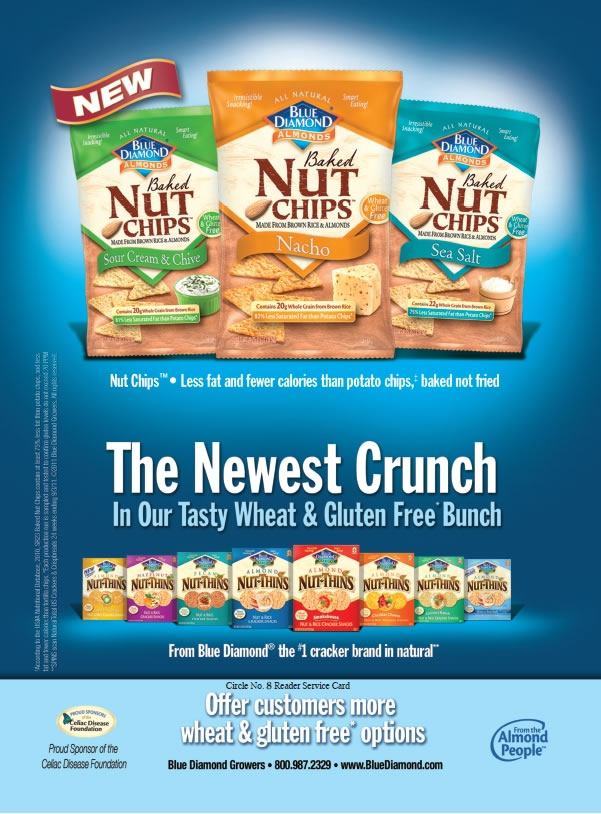
While eating foods containing large amounts of mannitol and sorbitol may leave you running to the John, others seem to have less of a laxative effect.
A person can, for instance, build up a tolerance to the effect in xylitol within weeks. Peldyak explains how: “You can start with xylitol found in dental products, and use it after meals to avoid any gastric discomfort while building up a tolerance. Gradually increase xylitol use. Avoid using large amounts of xylitol in liquids on an empty stomach.”
Levin adds that erythritol may be an exception to the rule, too: “[It] is considered virtually non-laxative because it is almost completely absorbed from the gastrointestinal tract, leaving little to attract water as it passes through the intestines. Unlike other sugar alcohols, very little of the absorbed erythritol is metabolized, with the vast majority harmlessly passing out via the urine.”
Sugar alcohols also vary in sweetness. According to Levin, xylitol is about as sweet as sugar, while erythritol is only about 70% as sweet. Others—like sorbitol, mannitol and maltitol—may only taste about half as sweet as sugar to most people.
Regardless, those who cannot or choose not to eat sugar love the fact that sugar alcohols offer sweetness without creating a negative glucose response. Says Peldyak, “Compared to table sugar xylitol is processed differently in our bodies. Xylitol is slowly absorbed and is much lower on the glycemic index than other sugars, which is said to require less insulin for the body to process it.”
Also, xylitol has the unique distinction of supporting dental health. It has been studied to help prevent the adhesion of bacteria to teeth, thus reducing decay and cavities by 80%, according to the Web site of Tundra Trading (maker of xylitol products). It also is used to support tooth enamel and in some respiratory products to reduce the adhesion of bacteria in nasal passages.
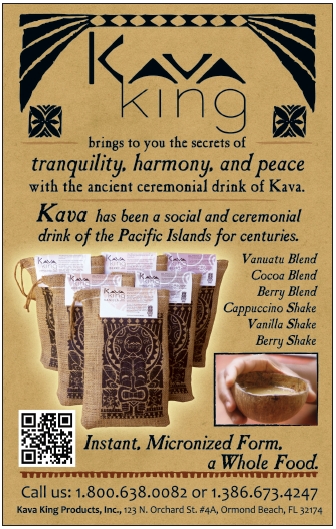 No Cane No Gain
No Cane No Gain
Despite the alternatives, natural/organic cane sugar and evaporated cane juice remain popular for their mild flavor and good mouth feel.
Levin breaks down how cane sugar is made: sugar cane is pressed and the molasses is separated out using a centrifugal turbine. “This is where the name Turbinado sugar comes from,” he states, noting that the end result is considered unrefined despite this process. The sugar can then be made into a liquid, syrup or dry sweetener.
Refined sugar, by contrast, takes the extra step of traveling to a refinery, where even more molasses (and brown color) is removed, making the end product stark white.
Making evaporated cane juice, says Clem, involves crushing the cane to remove the juice, which is then filtered and clarified to remove impurities. “The juice is then heated to evaporate off excess liquid, and crystallization is enduced. The resulting crystals are then cleaned and dried,” she says, noting they aren’t chemically decolorized or further refined.
Some organic cane juice makers take extra care to ensure processing is done quickly for freshness. Says Florida Crystals of its process, “The cane is harvested and milled the same day using a single crystallization process to preserve the original sun-sweetened flavor, and product-enhancing attributes.”
We can again compare this process with what happens during refined sugar production. Says Clem, “After the initial processing at the sugar mill, the raw sugar is shipped to a refinery in bulk, where it is re-melted to produce a syrup that is then recrystallized. The resulting crystals are then subjected to further refining processes to remove molasses and color. The end product is white refined sugar. Various chemicals are used in the production of white refined sugar.”
Adding in varying amounts of molasses will change the final product. Producers can leave in a hint of the molasses to make demerara sugar, remove about 2/3 of the molasses to make turbinado sugar or add the molasses back in to make brown sugar. Plus, trademarked Sucanat is made by crystalizing sugar cane juice with most of the original molasses content, says Levin, whose company offers organic turbinado sugar and Sucanat.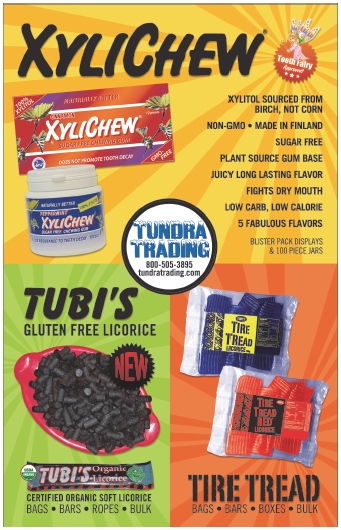
Cane versus corn. In some ways, natural cane options are going head to head with HFCS as companies are increasingly turning away from the latter. States Clem, “Both HFCS and the majority of beet sugar are made from GMO crops. Evaporated cane juice is a first crystallization sugar. It is minimally processed sugar from sugar cane.”
One positive of evaporated cane juice, according to Clem, is that it is far less processed than white refined sugar, which means it has some extra nutrients. “It retains more of the naturally occurring molasses, minerals and other elements of the cane juice, all of which are removed from white refined sugar by the refining process,” she states.
Of course, some are watching the war of words with respect to HFCS. Proponents say that the sweetener is no worse for the body than sugar. Others blame HFCS for increased incidence of diabetes and obesity (see sidebar, “War on Sugar”). Given the bad press, manufacturers recently asked the U.S. Food and Drug Administration to let them call HFCS “corn sugar” on product labels. Just before press time, several consumer groups petitioned the agency to deny the request. FDA is still weighing both sides of the issue (see this month’s grocery news for more).
Trendy Sweeteners
Companies always seem to be on the lookout for something new and different from sweetener suppliers.
A somewhat new trend is coconut palm sugar (also called coconut sugar). It has a medium glycemic index and a sustainable supply. States Victoria Hartman, executive vice president at Madhava Natural Sweeteners, Longmont, CO, which markets this and other sweeteners, “Coconut sugar is sustainably harvested from the nectar of the coconut palm tree, which produces 50–75% more per acre than cane sugar, while only using 20% of the resources.”
Clem says her company gets its Organic Coconut Palm Sugar “by tapping the sweet nectar from the tropical coconut palm tree flower and drying the nutrient-rich juice in a large open kettle drum. The juice condenses into a delicious, hand-made whole brown sugar.”
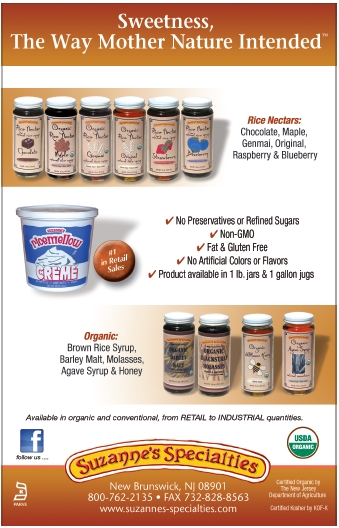 Hartman adds that coconut palm sugar is easy to use at home: “It’s a one-to-one replacement, making it simple to use in your favorite recipes or wherever you would use sugar.” It also has some nutritional value, like retaining its naturally occurring vitamins and minerals including magnesium, potassium, zinc, iron, B vitamins and amino acids, according to Hartman.
Hartman adds that coconut palm sugar is easy to use at home: “It’s a one-to-one replacement, making it simple to use in your favorite recipes or wherever you would use sugar.” It also has some nutritional value, like retaining its naturally occurring vitamins and minerals including magnesium, potassium, zinc, iron, B vitamins and amino acids, according to Hartman.
In terms of other trending sweeteners, stevia suppliers continue to innovate. For instance, flavored stevia is popular. “There are various innovative ways the stevia manufacturers are enhancing current stevia products and developing new ones to encourage consumer interest and generate trial,” says Jim May, CEO and founder of SweetLeaf Stevia Sweetener, Gilbert, AZ. “Flavors, particularly vanilla and lemon, are being added to packets.”
Wisdom Natural Brands, the parent company of SweetLeaf Stevia Sweetener, continues to add flavors to its liquid stevia line. New at press time were another three flavors: coconut, watermelon and cola. “Of particular interest is a cola flavor, which has captured much attention with consumers who want to enjoy a delicious soda when the convenient drops are served in sparkling water but don’t want any calories, carbs or sugars in their diets,” says May.
Another innovation is combining stevia with other sweeteners. May feels that stevia is a good companion to monk fruit or cane sugar. Sugar may seem like a surprising pairing with what some view as a sugar alternative. But, May says, “In an effort to maintain the familiar taste and ‘mouth feel’ of sugar while substantially reducing the calories and carbs of sugar, some manufacturers are combining stevia with sugar using different methods and ratios—and different kinds of sugar.” This means that the sugar used could range from highly to minimally processed cane sugar. This could cut calories from 25–30% to 50%.
Rather than using the combination technique, SugarLeaf developed something unique. The firm coats sugar cane molecules with stevia. The coated sugar is then added to minimally processed cane sugar to achieve “a product that looks like sugar, tastes like sugar, bakes like sugar, and browns like sugar, and yet is 66% fewer calories than sugar per serving.”
Meanwhile, Truvia recently launched a new stevia Rebiana A syrup for low-calorie beverages in bars and restaurants “to help operators meet the growing demand for reduced-calorie cocktails.”
Other sweeteners have food and beverage companies talking, too. Though not new, maple syrup is getting a second look by shoppers for its great taste and diverse uses. Levin notes that pure maple syrup is “graded by the amount of light transmission through a standard column of syrup, which actually indicates the content of constituents like bioflavonoids and minerals that are not classed as impurities.” NOW offers several varieties of maple syrup.
Agave nectar continues to be popular, and has a noteworthy quality: it’s a source of prebiotics. Once the juice is extracted from the agave plant, it is filtered and then heated to break down the prebiotic fiber FOS (fructooligosaccharides). Levin notes that FOS “aids the growth of beneficial intestinal bacteria such as bifidus.”
Hartman adds her two cents. “Agave nectar continues to gain popularity as people learn more about it from Dr. Oz and others who recommend it as a great natural alternative to processed sugar,” she states. “People like that it’s 1.4 times sweeter than sugar, so they can use less.”
Despite its sweetness, some agaves have impressive marks on the glycemic index scale. Says Jim Snyder of Sohgave!, Superior, CO, “Sohgave! has been tested and certified with a glycemic index of 17. I have not seen any other brand with the certificate logo displayed on their label as we have.” He adds, “We only use the Blue Weber Agave in our products, which is from the same variety used in tequila production.” WF
References
1. B. Kelm, “Controversy Deepens Over Pesticides and Bee Collapse,” Apr. 6, 2012, www.wired.com/wiredscience/2012/04/neonicotinoids-colony-collapse, accessed Apr. 24, 2012.
2. P. Rothstein, “Demystifying ‘Sugar Alcohol’: Is it a Suitable Substitute for Ordinary Sugar?” Mar. 1, 2012, www.naturalnews.com/035109_sugar_alcohol_sweeteners_health.html, accessed Apr. 24, 2012.
Published in WholeFoods Magazine, June 2012

